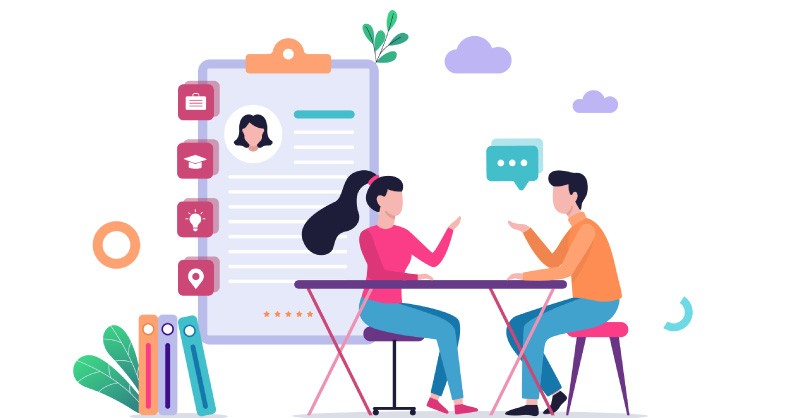An interview guide is a crucial document that helps organizations standardize and structure their candidate interviews. It provides interviewers with a framework for asking relevant questions in a consistent order, ensuring a fair and uniform candidate experience for all applicants. The specific content of an interview guide will vary based on the role, the chosen interview method, and the organization’s specific requirements.
The Benefits of Using an Interview Guide
Implementing an interview guide offers numerous advantages throughout the hiring process:
-
Structured Process: Using a standardized guide ensures a consistent and structured interview process. This minimizes the risk of interviewers overlooking crucial questions or failing to provide essential information to candidates.
-
Enhanced Candidate Experience: Interview guides help create a level playing field, providing all candidates with a similar interview experience. While individual interviewer styles will naturally vary, the core process and questions remain consistent.
-
Objective Assessment: By using the same interview method and questions for each candidate, you can implement a standardized scoring system for more objective evaluations. This reduces potential bias in the interview process.
Key Elements of an Effective Interview Guide
An effective interview guide should be an integral part of a well-defined selection process. It should align with every stage of the process, taking into account the requirements outlined in the job description, including the skills, personality traits, and capabilities needed for the role. Here are seven essential elements:
1. Invitation & Briefing
Ensure all candidates receive a comprehensive and consistent interview invitation, outlining what to expect during the interview. This should include the number of interviewers, the duration of the interview, whether any preparation is needed, and what documents to bring.
Here’s an example of an interview invitation email:
Subject Line: [COMPANY NAME]: Interview Availability
Hi [FIRST NAME],
Thank you for applying to the [JOB TITLE] position at [COMPANY NAME]. We’ve reviewed your application materials carefully, and we’re excited to invite you to interview for the role!
Your interview will be conducted [FORMAT] and last roughly [LENGTH OF INTERVIEW]. You’ll be speaking with [INTERVIEWER], our [INTERVIEWER JOB TITLE], and [INTERVIEWER], our [INTERVIEWER JOB TITLE] here at [COMPANY NAME].
Please let us know when you are available during the following times:
[DAY, DATE – TIME, TIME ZONE]
[DAY, DATE – TIME, TIME ZONE]
[DAY, DATE – TIME, TIME ZONE]
Don’t forget to bring your [DOCUMENTS] and the [WORK SAMPLE TEST] you prepared.
Thanks again for your interest in joining the [COMPANY NAME] team! We’re looking forward to speaking with you.
Best,
[YOUR NAME]
[YOUR EMAIL SIGNATURE]
Your company’s invitation template can be linked within the interview guide. This guarantees all candidates receive the necessary details.
2. Setting the Stage
Consider the practical aspects of the interview setting. Determine where interviews will be conducted, who will be the interviewers, and, for video interviews, the optimal location for the call. Consistency in the setting is key to providing a fair experience for each candidate. Document requirements, for both online and offline setups, within the interview guide.
 Setting the stage for an interview
Setting the stage for an interview
If interviewers need specific documents such as candidate resumes, work samples, or the interview guide itself, this should be explicitly stated within the guide.
3. Welcome
The welcome should include key information about the company, its history, the office environment, and the specifics of the job role. Include a detailed interview opening, covering all relevant aspects, in the interview guide.
4. Questions
Structured interviews utilize a standardized set of questions. This ensures that interviewers consistently gather information and evaluate candidates based on the same criteria. It also enables accurate comparison of candidates and data-driven decision-making.
The STAR method is a popular technique used to gather information from candidates in a structured way. STAR stands for:
- Situation: Have the candidate describe the situation they were in.
- Task: What goal was the candidate trying to achieve?
- Action: Ask the candidate to describe the specific actions they took.
- Result: Have the candidate describe the outcome of their actions and what they learned.
Using the STAR method to evaluate key job competencies is highly recommended. Asking the same questions to each candidate facilitates easy comparison of their experience in these competencies.
Ensure your interview guide aligns with your recruitment process; the questions should assess the key competencies and skills outlined in the job description.
5. Candidate Questions
Include a dedicated section in your interview guide for candidate questions. The questions a candidate asks (or doesn’t ask) can reveal their interest in the role and the organization.
6. Wrap-Up
Before concluding the interview, several key steps should be followed. First, thank the candidate for their time. Second, clearly outline the next steps in the hiring process, including the timeline for a decision and the method of communication. Third, if not already obtained, request references and contact information. Fourth, provide a point of contact for any follow-up questions. Document all of these steps within your interview guide.
7. Scoring
After the interview, immediately evaluate the candidate’s performance. Score each question based on pre-defined criteria. Interviewers should complete this scoring process as soon as possible while the interview is still fresh in their mind.
Interview questions can be categorized based on factors such as person-job fit and person-organization fit. Person-job fit questions assess a candidate’s compatibility with the job requirements, while person-organization fit questions evaluate their alignment with the company culture.
While person-job fit questions are role-specific, person-organization fit questions are generally applicable across different positions. Consider including person-organization fit questions directly in the interview guide or providing a link to a shared resource containing these questions.
Final Thoughts
Utilizing an interview guide is an effective way to ensure equitable treatment of all candidates. It provides structure to the interview process, facilitates objective assessment, and ultimately helps in making informed hiring decisions. While the specific content of each guide will vary, the core elements outlined above provide a solid foundation for any organization.